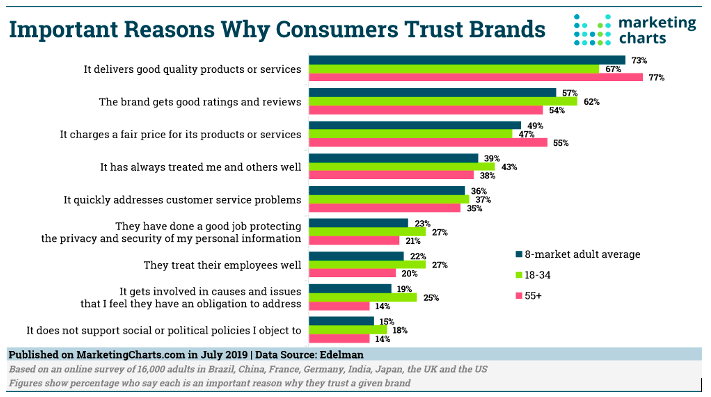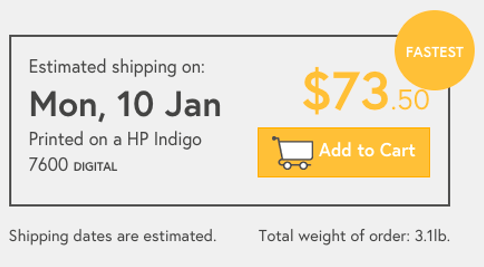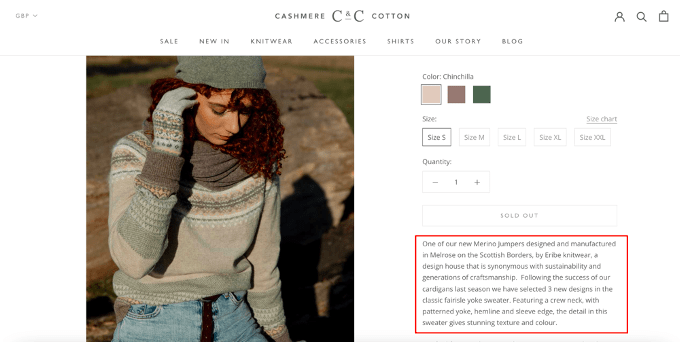
There are various reasons consumers choose to buy a product or support a particular brand over another.
People make online shopping decisions based on several factors. The top 3 included price point, shipping speed, and convenience. However, the truth is, it’s not just value for money or free shipping that consumers want when shopping (online or offline).
They also give a lot of thought to whether a brand they’re considering deserves their trust.
Trust is the ingredient that can help brands soar. And, as we’ve seen in the case of The Honest Company, the loss of it can make them crash and burn just as quickly.
So how exactly can businesses build brand trust? And what is brand trust in the first place?
By definition, brand trust shows whether consumers have confidence in a business.
Essentially, people will trust brands that deliver on their promises, stay true to their mission and values, enjoy good ratings and reviews, treat consumers with respect, and address any arising issues quickly and professionally.

And, if brand trust determines an organization’s reputation, it’s safe to say that it will also boost brand awareness and, consequently, increase sales.
So, what does it go into establishing a business as a trustworthy brand? Well, there are several effective tactics brands can use in their branding strategy to prove that they’re the right choice for consumers.
Here are the 5 most effective tips for building brand trust:
The first step towards establishing a trustworthy brand is to approach the branding process from a trust-oriented point of view.
What do we mean by this? It simply means defining the brand’s purpose and mission and clearly communicating them to the target audience. In case you’re wondering:
● Brand purpose is the reason a business exists. This may be to provide quality goods, positive experiences, or do some form of social good. The World Wildlife Fund’s purpose, for example, is to
“protect communities, wildlife, and the places in which they live.”
● Brand mission represents an organization’s goals. For The Body Shop, it is to provide “ethically sourced and naturally-based ingredients from around the world, in no-nonsense packaging [consumers] could easily refill.”

As you can see, the best way to drive trust is to compose a well-worded mission/purpose statement.
But having that statement on your site’s “about section” is not enough. To ensure that it really does its job of communicating to website visitors that you’re a business dedicated to bringing them value, make sure that it has a prominent spot on your homepage.
For example, Future Kind places its mission statement right on its homepage. The message itself is humble, relatable, and believable. What makes it stand out is the picture of the two founders, putting a face behind the words and making them that much more authentic.

The second essential thing to do when positioning your brand as a trustworthy business is to practice what you preach. That is, to be consistent about delivering on promises and staying true to your values.
How do you do this in the real world?
For one, be clear about the values your organization stands for. WhatsGood does this spectacularly by saying that it’s a company
“passionate about local food and believe[s] localized food systems are a necessity for a sustainable future.”
But much more important than expressing your values, make sure that you also support them with your actions.
What makes ‘WhatsGood’ successful is that it works hard to fulfill its mission. Moreover, the brand actively works to educate its customers about local food systems with an in-depth help center that addresses tons of questions, from technical ones regarding how to use the brand’s app to those that pertain to the way products are sourced and processed and what that means for the consumer.
The third tip for building brand trust is to practice transparency in all your communication with your customers.
This doesn’t just mean avoiding false advertising. More than that, you need to be honest about what your products can and can’t deliver. Try to provide as much information as possible, especially if having that information might help your customers have a better overall shopping experience with your brand.
For example, if preparing and shipping an item requires more than a couple of days, be sure to provide your customers with an estimate about when they can expect their package. Check out how Mixam did just that.

Or, if the services you provide aren’t easily understandable, make sure that you give potential clients insights into what the collaboration process will look like and what they can expect to walk away with.
This is what Mrs. Property Solutions does with its How Our Home Buying Process Works page, which covers everything homeowners need to know about selling their property.

Or, if you’re an ecommerce business, you could even take things a step further. You can provide in-depth info about where you source your materials, like Cashmere Cotton does.

Another excellent strategy for building brand trust is to ensure that your business is fully committed to making your customers happy.
Research about customer service shows that consumers trust businesses that are easily reachable and are efficient when resolving customer issues. In fact, as many as 95% of people say that customer service impacts whether they will remain loyal to a brand.
So knowing how important it is for people that your brand will be there for them, make sure that they know you will.
For one, try to include several contact options on your website. Moreover, aim to be there for your clients on all the platforms they use.
For example, if they tend to spend a lot of time on Twitter, it might not be a bad idea to have a dedicated support profile on the social network, like Ubisoft does. Seeing how the video game company gets hundreds (if not thousands) of support requests per day, it’s only natural it wants to make it easy for all of its customers to get in touch, regardless of their preferred communication channel.

If you’re a small business and can’t handle more than a couple of communication channels, don’t promise support through every single one available out there.
Instead, focus on providing help through the channels you can cover and make sure that you’re always quick, efficient, and most importantly, kind.
Finally, if you’re looking for a way to instantly boost brand trust (ideally while also committing to the long-term strategies we talked about), don’t forget to add trust signals to your website and social media profiles.
Trust signals come in many forms:
They can be badges showing that your business complies with relevant security standards, like the ones used on the Homestead Supplier website, to inform customers about the 30-day money-back guarantee and secure checkout options offered by the brand.

You can display social proof on your homepage and social media profiles. Do this by integrating Trustpilot and Google ratings, sharing reviews from your satisfied customers, and displaying user-generated images. For a great example, take a look at how Axios Watches did it.

Don’t forget to make it easy for customers to find applicable policies. Ensure that your Terms of Service, Privacy Policy, and Returns Policy pages are easily accessible. What is more, don’t hesitate to link to them at the relevant stages of the buyer’s journey, for example, at your checkout page.
Building brand trust may not be easy or quick. But the truth is, it’s a branding strategy that’s very much deserving of your attention, as it holds the potential of driving your business’s success. So don’t hesitate to try and implement the tips we’ve talked about here.
Of course, always remember that brand trust isn’t just influenced by what you say. Much more than that, it depends on what you do.
So, in addition to trying out all these tactics, don’t forget to pay attention to everything that might impact your business’s reputation. That includes a continual commitment to delivering high-quality products and services, aligning all your content with your values, and, finally, continually listening to your audience. You’ll want to make any necessary changes to guarantee their satisfaction.
The information provided on this page is for information, educational, and/or editorial purposes only. It is not intended to indicate any affiliation between Tailor Brands and any other brand or logo identified on this page.
Products
Resources
@2024 Copyright Tailor Brands